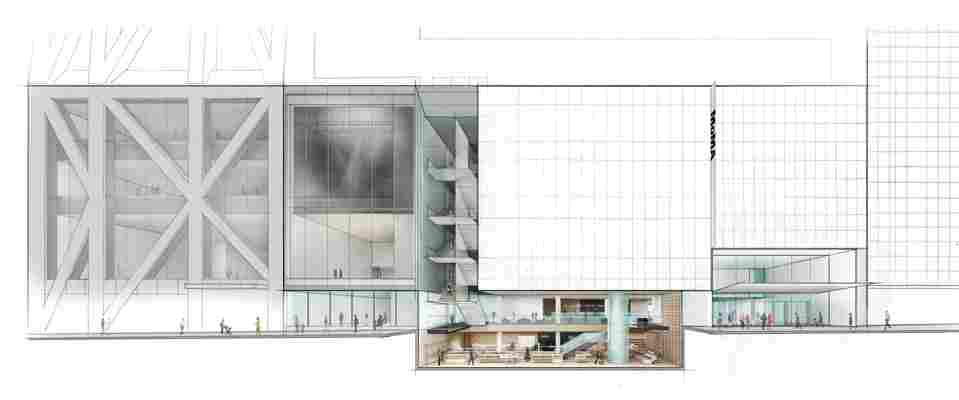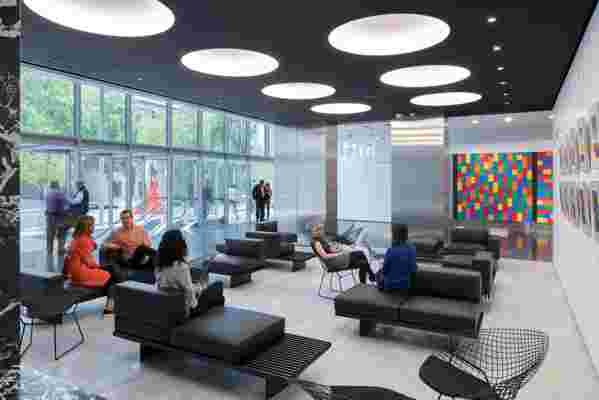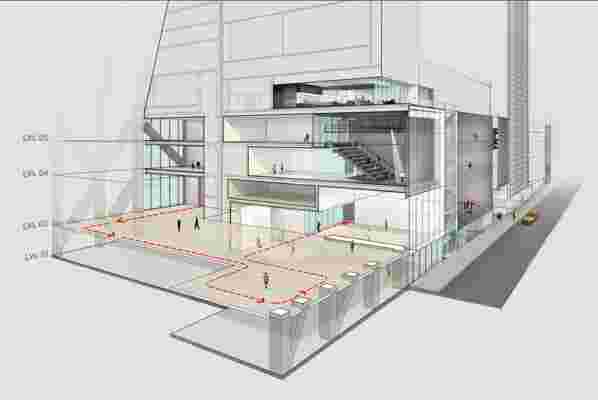The MoMA Expansion by Diller Scofidio + Renfro
The expansion of New York’s Museum of Modern Art , a project that has involved the destruction of one building on West 53rd Street (the American Folk Art Museum by Tod Williams Billie Tsien Architects) and the construction of another (a condo tower by Jean Nouvel ), took an important turn this week. The museum unveiled the first stage of a renovation by Diller Scofidio + Renfro in collaboration with Gensler , including an expanded “auxiliary” lobby at 11 West 53rd Street; a new lounge area and bookstore on the second floor; and newly configured galleries on the third. The expanded lobby (east of the existing main entrance) is an elegant space, its walls covered in dramatically veined black marble and its floors in black terrazzo. Overall, the work is a restrained offering from DS+R, a firm that, in other contexts, can be far more radical.

Elevation of The Museum of Modern Art on 53rd Street with cutaway view below streetlevel.
With the new auxiliary lobby ready for the onslaught of visitors—attendance at MoMA was 3.2 million last year, or an average of almost 10,000 a day—the museum will be able to close its main 53rd Street entrance. That will enable it to begin the next, and far more extensive, phase of the renovation. In that phase, the museum store will move below grade, “so you don’t first confront retail when you see the museum from the street,” says DS+R partner Elizabeth Diller. The lobby will be reconfigured to ease congestion, and a new series of galleries will be constructed. Some of those spaces, including one that can be used for performance, will occupy 45 West 53rd Street, the site of the American Folk Art Museum, which was demolished in 2014.

View of The Marlene Hess and James D. Zirin Lounge.
Others will occupy the second, fourth, and fifth floors of the new Nouvel skyscraper, which is named for its address, 53 W 53. From those galleries, visitors will get to see Nouvel’s crisscrossing, “diagrid” structure. “It’s like a found object,” says museum director Glenn Lowry of the girders’ sculptural qualities. Altogether, the renovation will give the museum about 50,000 square feet of new gallery space, for a total of 175,000 square feet. And it will add greater variety of spaces—“we need small, medium, and large galleries,” says Lowry. The renovation is a response to vast increases in attendance as well as shortcomings of the expansion by Yoshio Taniguchi, which was unveiled to great fanfare in 2004. (Earlier buildings were by Edward Durell Stone and Philip L. Goodwin; Philip Johnson; and Cesar Pelli.)

North/south section-perspective through the new gallery spaces at The Museum of ModernArt, looking east along 53rd Street.
The renovation, expected to cost more than $400 million, is scheduled to wrap up in 2019. It will prepare the museum for even greater popularity. “If attendance reaches 4 or 4.5 million a year, it will still feel comfortable,” says Lowry (though he says he doesn’t expect such a large increase). He adds that, at its current site, MoMA will not be able to build additional square footage.
View of the restored Bauhaus staircase, with Oskar Schlemmer’s Bauhaus Stairway (1932).
Diller describes the project as “archaeological, almost surgical.” Pipes and ducts running through the existing MoMA buildings made many ideas non-starters. “It’s a rat’s nest of previous logics,” she says of the structure she inherited, adding that her goal is to make some “very tricky moves look effortless.”